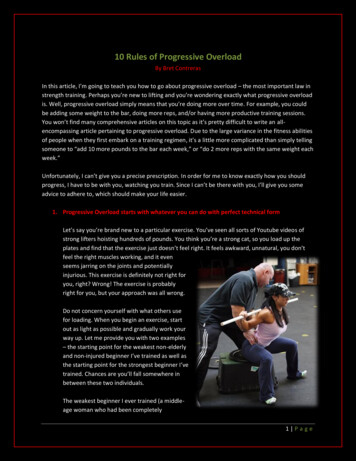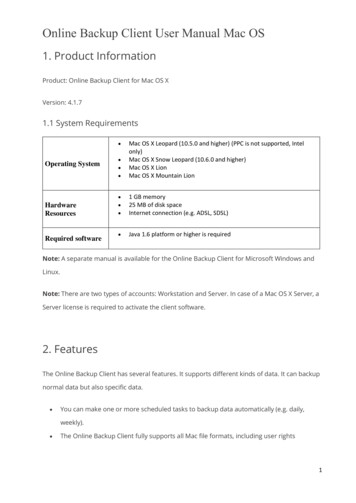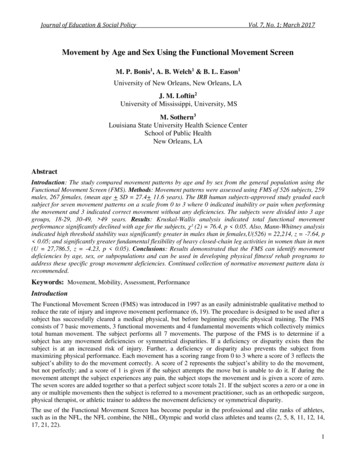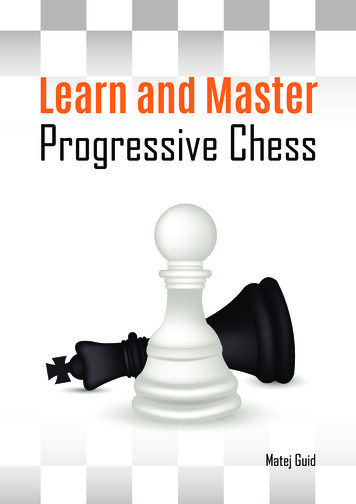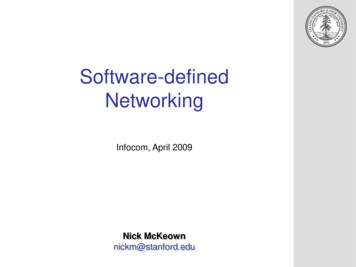
Transcription
1890–1919The ProgressiveMovement. The Big Ideas ,SECTION 1: The Roots of ProgressivismSocial and economic crises lead to new roles for government. As Americans became more awareof the social problems affecting the United States, progressives began to look to the government to helpsolve these problems and regulate big business.SECTION 2: Roosevelt in OfficeSocial and economic crises lead to new roles for government. When Theodore Roosevelt, a progressive, won the presidency in 1901, progressivism entered national politics.SECTION 3: The Taft AdministrationSocial and economic crises lead to new roles for government. William Howard Taft was a moremoderate progressive than Theodore Roosevelt, but he still continued several progressive reforms.SECTION 4: The Wilson YearsSocial and economic crises lead to new roles for government. When the Progressive era ended,the role of the federal government had changed, and people expected the government to take actionin regulating the economy and solving social issues.The American Vision: Modern Times Video The Chapter 5 video,“The Stockyard Jungle,” portrays the horrors of the meatpacking industry first investigatedby Upton Sinclair.1889 Hull Houseopens inChicago1890 Jacob Riis’s Howthe Other HalfLives published B. Harrison1889–1893 Cleveland1893–18971902 Maryland workers’compensation lawspassedMcKinley1897–1901T. Roosevelt1901–19091890 1884 Toynbee Hall, first settlementhouse, established in London1904 Ida Tarbell’s History ofthe Standard OilCompany published 19001900 Freud’s Interpretationof Dreams published 1902 Anglo-Japanesealliance formed1903 Russian Bolshevik Party established by Lenin322 CHAPTER 12Becoming a World Power
Women marching for the vote in New York City, 19121905 Industrial Workersof the Worldfounded Taft1909–19131913 SeventeenthAmendmentratified1910 Mann-ElkinsAct passed1906 Pure Food andDrug Act passed1920 Nineteenth Amendmentratified, guaranteeingwomen’s voting rights HISTORYWilson1913–1921 Chapter Overview1910 1910 Mexican Revolution1905 Einstein’s theory ofrelativity formulated1920 1914 World War I beginsin EuropeVisit the American Vision:Modern Times Web site attav.mt.glencoe.com andclick on Chapter Overviews—Chapter 5 to preview chapterinformation.323
Making InferencesWhen people read a text, they do not just read the text itself. They alsouse a skill called making inferences to understand the meaning of thetext. This is sometimes called “reading between the lines.” It means thatreaders look for clues that might explain what is occurring in a passageeven though it may not be openly stated. Readers think about what theyalready know and draw conclusions based on this knowledge. Authors relyon a reader’s ability to infer. They usually cannot include all the details in atext, because it would make passages needlessly long and repetitive.As you read a text and make inferences, you must think about your ownbackground knowledge. You will also use several reading strategies youlearned earlier, including predicting and questioning. When you combineall of this information, you can understand the greater message the authoris trying to convey.Read the following paragraph about President Theodore Roosevelt and GiffordPinchot, first head of the U.S. Forest Service, and make inferences about thepolitical beliefs of progressives.MAKING INFERENCESUse your background knowledgeto understand the passage. Whatdo you remember reading aboutRoosevelt taking on big businessesand trusts?As progressives, Roosevelt and Pinchot bothbelieved trained experts in forestry and resourcemanagement should apply the same scientific standards to the landscape that others were applyingto the management of cities and industry. Theyrejected the laissez-faire argument that the bestway to preserve public land was to sell it to lumbercompanies, who would then carefully conserve itbecause it was a source of their profits. WithPresident Roosevelt’s support, Pinchot’s department drew up regulations to control lumberingon federal lands. (pages 344–345)As you read, you can identify which policiesRoosevelt and Pinchot supported and whichthey opposed. Both believed in scientific standards of forestry management and regulationof the lumber industry. They opposed a laissezfaire approach to managing and selling publicland. You also can infer that the president didnot trust the lumber industry to operate in thepublic interest and therefore government regulations were necessary.Read the text under the heading “Beginnings of Progressivism” on pages327–328. As you read, identify the information you gather from the text.Then think about the background knowledge from earlier chapters youhave used to understand the passage.324
Interpreting EventsAnalysis SkillStandard H14Historical Interpretation When you learn to interpret events, it helps you understandtheir meaning, implication, and impact. One way to interpret is by recognizing and examining how events could have taken other directions.As you complete your high school education, you might be thinking aboutwhat you will do after graduation. Perhaps you will go to college, or you areconsidering a job in a specific industry. Consider how your life will be affected byyour final decision. Will you stay close to your hometown, or will you move toanother state? Will you work for a small company or a multinational corporation?Imagine the people that you won’t meet and the experiences you may not have bychoosing one direction over another, and the impact this choice could have on thedirection of your life.When historians interpret past events, they too consider how different choicesmight have affected the course of history. Using this skill helps them analyze pastevents. It also helps them understand the impact of decisions that were madebased on the events of the time.Read this passage from your textbook about the suffrage movement at the end of the Civil War.The debate over the Fourteenth and Fifteenth Amendments split the suffrage movement into two groups: the National Woman Suffrage Association, . . . and the AmericanWoman Suffrage Association. . . .This split reduced the movement’s effectiveness. In 1878 a constitutional amendmentgranting woman suffrage was introduced in Congress, but it failed to pass. Few stategovernments granted women the right to vote either. . . . By 1900 only Wyoming, Idaho,Utah, and Colorado had granted women full voting rights. (page 331)Consider how long it took for women to gain the right to vote. Why would eachgroup focus on their own strategy for gaining voting rights? How might the outcome have been different had the two groups agreed on a unified strategy? Howdo you think the split affected history?Choose one of the major areas on whichprogressives focused, such as childlabor, temperance, or trusts. Review thevarious events regarding the topic. Thenconsider how events might haveunfolded differently if muckrakers andreformers had not turned their attentionto your chosen issue.325
The Roots ofProgressivismGuide to ReadingConnectionIn the previous chapter, you learned howthe United States increased its power andinfluence around the world. In this section, you will discover the beginning ofthe Progressive movement and a focuson domestic reform. The Progressive movement was anattempt to use scientific principles toimprove society. (p. 327) One form of progressivism focused onways to use business practices to makegovernment more efficient. (p. 328) Progressive policies in Wisconsinbecame widespread, leading to electionreforms. (p. 330) Many progressives joined the suffragemovement to gain women the right tovote in national elections. (p. 330)Preview of Events 189011.5.4 Analyze the passage of theNineteenth Amendment and the changingrole of women in society.326CHAPTER 5progressivism, muckraker, commissionplan, direct primary, initiative, referendum, recall, suffrage, temperance, prohibition, socialism Evaluate the impact of initiative,referendum, and recall, and of theSeventeenth Amendment.Reading StrategyOrganizing As you read about thebeginnings of progressivism, completea graphic organizer similar to theone below by filling in the beliefsof progressives.Academic Vocabularylegislation, strategy, funds, advocateProgressiveBeliefsPeople and Terms to IdentifyJacob Riis, Robert La Follette, Alice PaulReading Objectives Discuss the rise of the Progressivemovement. 19101901Galveston, Texas,adopts commissionsystem1913Seventeenth Amendmentprovides for directelection of senators 19201920Nineteenth Amendmentgives women the rightto vote. The Big Idea ,The following are the mainHistory–Social Science Standardscovered in this section.11.5.3 Examine the passage of theEighteenth Amendment to the Constitutionand the Volstead Act (Prohibition).Content Vocabulary 19001890Jacob Riis’s How the OtherHalf Lives published11.2.9 Understand the effect ofpolitical programs and activities ofthe Progressives (e.g., federal regulation of railroad transport, Children’sBureau, the Sixteenth Amendment,Theodore Roosevelt, Hiram Johnson). Many progressives focused on socialwelfare problems, such as child labor,public health, and prohibition. (p. 333) Another form of progressivism focusedon federal regulation of big business.(p. 335)Social and economic crises lead to new roles for government. During the late1800s, Americans again became concerned with social problems in the United States.Progressives focused on a variety of issues and how to address them. Some believed thatgovernment should solve social problems, while others thought that science or businessheld the answers. Many progressives focused on improving government by making iteither more efficient or more democratic. Others joined in the suffrage movement andworked to gain women the right to vote in national elections. Still other progressivesfocused on child labor, public welfare, prohibition, and regulation of big business.The Progressive Movement
The Rise of ProgressivismThe Progressive movement was an attemptto use scientific principles to improve society.Reading ConnectionWhat areas of public life do youbelieve still need to be reformed? Read on to learn about amovement in the late 1800s that tried to reform many of the illsof society at the time.In the early 1900s, as the effects of industrialization and urbanization became apparent, a series ofreform efforts transformed American society. Thesereforms ranged from government reform to socialwelfare and woman suffrage. Historians refer to thisera in American history—from about 1890 to 1920—as the Progressive Era.Progressivismwas not a tightly organized political movement witha specific set of reforms. Instead, it was a collection ofdifferent ideas and activities. Progressives had manydifferent views about how to fix the problems theybelieved existed in American society.Progressives generally believed that industrialismand urbanization had created many social problems.Most agreed that the government should take a moreactive role in solving society’s problems. Progressivesbelonged to both major political parties and usuallywere urban, educated middle-class Americans. Manyleaders of the Progressive movement worked as journalists, social workers, educators, politicians, andmembers of the clergy.Beginnings of ProgressivismProgressivism waspartly a reaction against laissez-faire economics andits emphasis on an unregulated market. After seeing the poverty of the working class and the filthand crime of urban society, these reformers beganto doubt the free market’s ability to address thoseproblems. At the same time, they doubted that thegovernment in its present form could fix those problems. First, they believed the government requiredreform. They concluded that before the governmentcould be used to fix the problems of society, the government itself must be fixed. In 1917 suffragist Rose Winslow and several otherwomen, including Alice Paul, founder of the NationalWoman’s Party, were arrested for obstructing trafficand blocking sidewalks. The women had been picketing the White House to draw attention to the fact thatwomen did not yet have the right to vote in federalelections. After being sentenced to seven months injail, Paul, Winslow, and other women prisoners wenton a hunger strike. Prison authorities forced the prisoners to eat. Winslow smuggled details of their plightout to the public:Who Were the Progressives?A police officer arresting two suffragists in Washington, D.C.We have been in solitary for five weeks. . . . I have“felt quite feeble the last few days—faint, so that I couldhardly get my hair brushed, my arms ached so. Buttoday I am well again. . . . [Alice Paul] dreaded forciblefeeding frightfully, and I hate to think how she must befeeling. . . . I am really all right. If this continues verylong I perhaps won’t be. All the officers here know weare making this hunger strike [so] that women fightingfor liberty may be considered political prisoners. . . .[W]e don’t want women ever to have to do this overagain.”—quoted in Jailed for FreedomProgressive reform efforts were not limited towomen’s voting rights. Progressives came from different backgrounds, focused on a variety of issues,and did not always agree on solutions to solve thenation’s problems.CHAPTER 5The Progressive Movement327
One reason progressives believed people couldimprove society was because they had a strong faithin science and technology. The application of scientific knowledge had produced the lightbulb, the telephone, the automobile, and the airplane. It had builtskyscrapers and railroads. Science and technologyhad benefited people; thus progressives believedusing scientific principles could also produce solutions for society.The Muckrakers Among the first people to articulate Progressive ideas was a group of crusading journalists who investigated social conditions andpolitical corruption. These writers became known asmuckrakers after a speech by President TheodoreRoosevelt:Now, it is very necessary that we should not flinch“from seeing what is vile and debasing. There is filthon the floor and it must be scraped up with the muckrake; and there are times and places where this service is the most needed of all the services that can beperformed. . . .”—Washington, D.C., April 14, 1906HistoryMuckrakers McClure’s published Ida Tarbell’s exposé on Standard Oil.What issues particularly concerned the muckrakers?By the early 1900s,HISTORYAmerican publishers werecompeting to expose theStudent Webmost corruption and scanActivity Visit thedal. A group of aggressiveAmerican Vision:Modern Times Web site10 and 15 magazinesat tav.mt.glencoe.comgrew in popularity at thisand click on Studenttime, including McClure’s,Web Activities—Collier’s, and Munsey’s.Chapter 5 for an activMuckrakers uncoveredityon the Progressivecorruption in many areas.movement.Some concentrated on whatthey considered the unfairpractices of large Americancorporations. In McClure’s, for example, Ida Tarbellpublished a series of articles critical of the StandardOil Company. In Everybody’s Magazine, CharlesEdward Russell attacked the beef industry.Other muckrakers targeted government. DavidGraham Philips described how money influenced theSenate, while Lincoln Steffens, another McClure’sreporter, reported on vote stealing and other corruptpractices of urban political machines. These werelater collected into a book, The Shame of the Cities.Still other muckrakers concentrated on socialproblems. In his influential book How the Other HalfLives, published in 1890, Jacob Riis described thepoverty, disease, and crime that afflicted many immigrant neighborhoods in New York City. The muckrakers’ articles led to a general public debate onsocial and economic problems and put pressure onpoliticians to introduce reforms.Reading CheckDescribing How did the muckrakers help spark the Progressive movement?Making Government EfficientOne form of progressivism focused onways to use business practices to make governmentmore efficient.Reading ConnectionIn what ways do you try to useyour time and resources wisely and efficiently? Read on to findout about political programs the progressives designed to makethe government more efficient.There were many different types of progressivism.Different causes led to different approaches, and progressives even took opposing positions on how tosolve some problems.328CHAPTER 5The Progressive Movement
One group of progressives focused on makinggovernment more efficient. They believed that manyproblems in society could be solved if governmentworked properly. Efficiency progressives took theirideas from business. These progressives believedbusiness had become more efficient by applying theprinciples of scientific management.The ideas of scientific management had beendeveloped in the late 1800s and were popularized byFrederick W. Taylor in his book The Principles ofScientific Management, published in 1911. Taylordescribed how a company could become more efficient by managing time, breaking tasks down intosmall parts, and using standardized tools.Efficiency progressives argued that managing amodern city required experts, not politicians. Theydid not want more democracy in government, forthey believed that the democratic process led tocompromise and corruption. In most Americancities, the mayor or city council chose the heads ofcity departments. Traditionally, these jobs went topolitical supporters and friends, who often knewlittle about city services.Efficiency progressives wanted either a commission plan or a council-manager system. Underthe commission plan, a city’s government would bedivided into several departments, which wouldeach be placed under the control of an expertA City and a StormOn September 8, 1900, a massive hurricane devastated the city of Galveston, Texas. About 6,000 peopledied. When the political machine that controlled thecity government proved incapable of responding to thedisaster, local business leaders convinced the state to letthem take control. In April 1901, Galveston introducedthe commission system of government. Under this system, Galveston chose five commissioners to replace themayor and city council.Four commissioners were local business leaders.When the city quickly recovered, reformers in othercities were impressed. Galveston’s experience seemedto prove the benefits ofrunning a city like a business by dividing its government into departmentsand placing each underan expert commissioner.Many other cities soon followed, adopting either thecommission plan or thecouncil-manager system.Mayor-Council FormVoterselectMayoractions approved byCity CouncilappointsHeads of CityDepartmentscarry out policySource: The World Book Encyclopedia.Commission FormVotersPolice CommissionerelectFire CommissionerBoard ofCommissionersParks CommissionerFinance CommissionerPublic Works Commissionerpass ordinances;control fundscarry out policySource: The World Book Encyclopedia.Council-Manager FormVoterselectCity Manager(Chief Administrator)hiresCity Council(makes policy)electsappointsHeads of City DepartmentsMayorSource: The World Book Encyclopedia.carry out policy
commissioner. These progressives argued that aboard of commissioners or a city manager withexpertise in city services should hire the specialiststo run city departments. Galveston, Texas, adoptedthe commission system in 1901. Other citiessoon followed.Reading CheckExplaining Why did progressiveswant to reorganize city government?Democracy and ProgressivismProgressive policies in Wisconsin becamewidespread, leading to election reforms.Reading Connection Do you remember how candidates were nominated for office during the early years of thenation? Read on to discover the progressives’ new method forchoosing candidates.Not all progressives agreed with the efficiencyprogressives. Many believed that society neededmore democracy, not less. They wanted to makeelected officials more responsive to voters.“Laboratory of Democracy”Political reformfirst came to the state level when Wisconsin voterselected Republican Robert La Follette to be governor. La Follette used his office to attack the way political parties ran their conventions. Because partybosses controlled the selection of convention delegates, they also controlled which candidates werechosen to run for office. La Follette pressured thestate legislature to require each party to hold adirect primary, in which all party members couldvote for a candidate to run in the general election.La Follette’s great reform success gave Wisconsina reputation as the “laboratory of democracy.”La Follette claimed, “Democracy is based uponknowledge. . . . The only way to beat the boss . . . is tokeep the people thoroughly informed.”Inspired by La Follette, progressives in other statespushed for similar electoral changes. To force statelegislators to respond to voters, three new reformswere introduced in many states. The initiativeallowed a group of citizens to introduce legislationand required the legislature to vote on it. Thereferendum allowed proposed legislation to be submitted to the voters for approval. The recall allowedvoters to demand a special election to removean elected official from office before his or her termhad expired.330CHAPTER 5The Progressive MovementDirect Election of SenatorsAnother reform theprogressives favored affected the federal government—the direct election of senators. As originallywritten, the United States Constitution directed eachstate legislature to elect two senators from that state.Political machines or large trusts often influenced theelection of senators, who then repaid their supporterswith federal contracts and jobs. By the early 1900s,muckraker Charles Edward Russell charged that theSenate had become “only a chamber of butlers forindustrialists and financiers.”To counter Senate corruption, progressives calledfor the direct election of senators by all state voters.In 1912 Congress passed a direct-election amendment. Although the direct election of senators wasintended to end corruption, it also removed one ofthe state legislatures’ checks on federal power. In1913 the amendment was ratified, becoming theSeventeenth Amendment to the Constitution.Reading CheckEvaluating What was the impact ofthe Seventeenth Amendment? What was it intended to solve?The Suffrage MovementMany progressives joined the suffrage movement to gain women the right to vote in national elections.Reading ConnectionHow would you feel if you wereunable to vote for your country’s leaders because of yourgender? Read on to find out how women defeated that biasin 1920.In July 1848, Elizabeth Cady Stanton and LucretiaMott organized the first women’s rights conventionin Seneca Falls, New York. Stanton proposed to thedelegates that their first priority should be gettingwomen the right to vote. The movement for women’svoting rights became known as the suffrage movement. Suffrage is the right to vote.Woman suffrage was an important issue for progressives. Although the suffrage movement began wellbefore progressivism emerged, many progressivesjoined the movement in the late 1800s and early 1900s.Early Problems The suffrage movement got off toa slow start. Women suffragists were accused ofbeing unfeminine and immoral. Several were physically attacked. The movement also remained weakbecause many of its supporters were abolitionists as
well. In the years before the Civil War, they preferredto concentrate on abolishing slavery and spent lesstime working for woman suffrage.After the Civil War, the Republicans in nts to the Constitution to protect the voting rights of African Americans. Several leaders ofthe woman suffrage movement had wanted theseamendments worded to give women the right to voteas well. They were bitterly disappointed whenRepublicans refused.The debate over the Fourteenth and FifteenthAmendments split the suffrage movement into twogroups: the National Woman Suffrage Association,led by Elizabeth Cady Stanton and Susan B. Anthony,and the American Woman Suffrage Association, ledby Lucy Stone and Julia Ward Howe. The NationalWoman Suffrage Association wanted to focus onpassing a constitutional amendment allowingwoman suffrage. The American Woman SuffrageAssociation believed that the best strategy was toconvince state governments to give women the rightto vote before trying to amend the Constitution.This split reduced the movement’s effectiveness.In 1878 a constitutional amendment grantingwoman suffrage was introduced in Congress, but itfailed to pass. Few state governments grantedwomen the right to vote either. With the woman suffrage movement divided between goals, it was difficult for the movement to be successful. By 1900 onlyWyoming, Idaho, Utah, and Colorado had grantedwomen full voting rights.The Movement Builds SupportIn 1890 the twogroups united to form the National AmericanWoman Suffrage Association (NAWSA). The movement still did not make significant gains, however,until about 1910. Part of the problem was convincingwomen to become politically active. As theProgressive movement began, however, manymiddle-class women concluded that they needed thevote to promote the social reforms they favored.Many working-class women also wanted the vote toensure passage of labor laws protecting women.As the suffrage movement grew, members beganlobbying lawmakers, organizing marches, and delivering speeches on street corners. By the end of 1912,Washington, Oregon, California, Arizona, andKansas had granted women full voting rights. OnMarch 3, 1913, the day before President Wilson’sinauguration, suffragists marched in Washington,D.C., to draw attention to their cause.in HistorySusan B. Anthony1820 –1906Susan B. Anthony was born inAdams, Massachusetts, to Quaker parents. Quakers were generally moresupportive of women’s rights thansome other groups, and so Anthonywas able to receive a good education.She finished her schooling at the age of17. Anthony then worked as a teacherin New York, but she was fired afterprotesting that her pay was one-fifththe amount of her male colleagues.She found another job, however, as aprincipal at New York’s CanajoharieAcademy. Between 1848 and 1863,Anthony was involved in both thetemperance and abolitionistmovements.Her involvement in the drive forwomen’s equality began in 1851 aftershe met Elizabeth Cady Stanton.Between 1854 and 1860, the duoattempted to change discriminatorylaws in New York. In 1869 Anthonyand Stanton organized the NationalWoman Suffrage Association andbegan promoting an amendment togrant woman suffrage. Anthony and12 other women illegally cast votes inthe presidential election of 1872. Theywere arrested and convicted, but thejudge feared that the jury would rulein Anthony’s favor. He dismissed thejury and fined Anthony instead. Sherefused to pay the 100 fine, but thejudge decided to let her go, afraid thatappealing the case might generatesympathy for the suffrage movement.In 1883 Anthony traveled to Europe,and she helped form the InternationalCouncil of Women in 1888. This organization represented the rights of womenin 48 countries. She died in Rochester,New York, in 1906. Though Anthonydid not live to see her dream of womansuffrage become reality, the UnitedStates government honored her byplacing her portrait on a new dollarcoin in 1979.CHAPTER 5The Progressive Movement331
Woman Suffrage, F.1911MONT.1914UTAH1870ARIZ.1912WYO.1869N. DAK.S. DAK.1918NEBR.COLO.1893N. 1918PA.OHIOW.VA. VA.KY.N.C.TENN.ILL. IND.MO.ARK.MASS.R.I.N.J. CONN.DEL.MD.S.C.MISS.TEXASN.Y.1917LA.ALA. GA.FLA.Full woman suffrage before 1920, withdate grantedPartial woman suffrage before 1920No woman suffrage until ratification ofthe Nineteenth Amendment1920 borderAlice Paul, a Quaker social worker who headedNAWSA’s congressional committee, had organizedthe Washington march. Paul, a graduate ofSwarthmore College who also received a Ph.D. fromthe University of Pennsylvania, was jailed threetimes for demonstrating for woman suffrage. Paulwanted to use protests to force President Wilson totake action on suffrage. Her activities alarmed othermembers of NAWSA who wanted to negotiate withWilson. Paul decided to leave NAWSA and formedthe National Woman’s Party. Her supporters picketed the White House, blocked sidewalks, chainedthemselves to lampposts, and went on hunger strikesif arrested.In 1915 Carrie Chapman Catt, a graduate of IowaState College (now Iowa State University) and apeace advocate, became NAWSA’s leader. Catt developed what she called her “Winning Plan” to mobilizethe suffrage movement nationwide in one final pushto gain voting rights. She also threw NAWSA’s support behind Wilson in the 1916 election. AlthoughWilson did not endorse a woman suffrage amendment, he supported the Democratic Party’s call forstates to give women the vote.332CHAPTER 5The Progressive Movement1. Interpreting Maps Which region led the way in granting woman suffrage?2. Applying Geography Skills Based on the map, whatregion would you suggest had the least amount ofcampaigning for woman suffrage?The Nineteenth AmendmentIn 1869, longbefore NAWSA was formed, Wyoming became thefirst state or territory to grant women the right tovote within its borders. Other states soon began tofollow Wyoming’s lead. As the suffrage movementgained momentum, more states granted womenthe right to vote, and Congress began to favor aconstitutional amendment. In 1918 the House ofRepresentatives passed a woman suffrage amendment. Wilson then addressed the Senate, asking it tovote for the amendment. Despite his efforts, theamendment failed to pass by two votes.During the midterm elections of 1918, Catt usedNAWSA’s resources to defeat two anti-suffrage senators. The following year, in June 1919, the Senatefinally passed the Nineteenth Amendment by justmo
gressive, won the presidency in 1901, progressivism entered national politics. SECTION 3: The Taft Administration Social and economic crises lead to new roles for government. William Howard Taft was a more moderate progressive than Theodore Roosevelt, but he still continued several progressive reforms. SECTION 4: The Wilson Years



